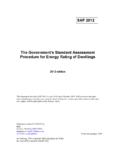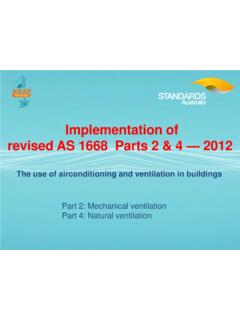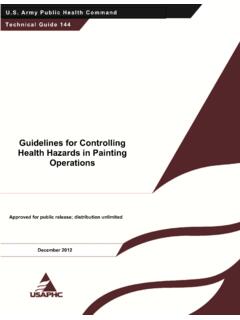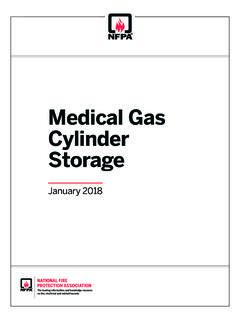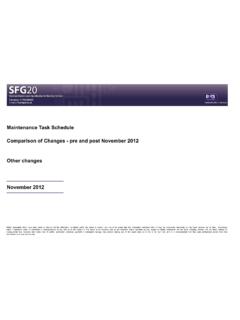Transcription of Fundamentals of Kitchen Ventilation - PDHonline.com
1 PDHonline Course M228 (2 PDH) Fundamentals of Kitchen Ventilation2012 Instructor: A. Bhatia, Online | PDH Center5272 Meadow Estates DriveFairfax, VA 22030-6658 Phone & Fax: Approved Continuing Education PDH Course M228 2012 A. Bhatia Page 2 of 30 Fundamentals of Kitchen Ventilation A. Bhatia, Course Content Introduction Ventilation is the single most important factor in the design, construction and operation of commercial kitchens. Without adequate Ventilation and an ample supply of clean makeup air, no Kitchen will operate efficiently. There are particular objectives which the Ventilation has to achieve. The objectives include the following: 1) The general Ventilation through the Kitchen has to introduce sufficient clean, cool air and remove excess hot air for the occupants to breathe adequately and remain comfortable.
2 2) The general Ventilation has to provide sufficient air for complete combustion at burning appliances, otherwise chronic debilitating carbon monoxide poisoning could occur. 3) The general and local Ventilation has to dilute and remove products of combustion from gas and oil fired appliances. 4) The general and local Ventilation has to dilute and remove odors, vapors and steam from the cooking processes. 5) Local Ventilation has to protect against particular hazards to health arising from some cooking fumes, such as those involving direct application of heat to the food. 6) The local Ventilation has to be capable of being kept clean from fat residues to avoid loss of efficiency and fire risks. 7) The system has to be quiet and vibration free. The amount of Ventilation required in a particular cooking area depends on various factors: the type of product(s) being cooked, the structure which houses the cooking area, the type of equipment used and local code regulations.
3 And, depending on your location, the building heat source may also play a factor. This course will provide basic guidelines to achieve these objectives and facilitate Ventilation design. Let s first understand key terminology and definitions related to Kitchen Ventilation systems. Definitions 1) Anemometer -A device used to measure air velocity. 2) Approved - Acceptable to the regulatory authority based on a determination of conformity with principles, practices, codes, and generally recognized standards. 3) Balance Report - A report completed by a qualified person, who after on-site testing of a Ventilation system, specifies in a report certain air volumes and the building s overall static pressure. 4) Compensating Supply Air - Air supplied through a plenum in the hood which is directed into the hoods capture area or down along the hood s perimeter. 5) Convection Oven A gas or electric heated oven that uses a fan or blower to recirculate the heat throughout the interior of the oven 6) Damper - A plate or other device within a duct for controlling the flow of gases.
4 7) Duct - means an enclosure for the transmission of air and vapors. 8) Grease - means rendered animal fat or vegetable shortening in any form, associated with cooking and other food preparation. PDH Course M228 2012 A. Bhatia Page 3 of 30 9) Grease Extractor - A device or a system of components (usually series of baffles installed in a hood) for reducing the grease concentration from the air stream entering the system and concentrating the grease for further action. 10) Grease Filter - A device that is installed in the exhaust hood in such a way as to remove grease from the exhausted air by entrapment, impingement, adhesion, or other similar means and allow it to drain to a grease trough. 11) Grease Laden Vapors/Air - Vapors in concentrated level of above 5 mg.
5 Per cubic meter released into the air due to grease being heated to its vaporization point. 12) Grease Removal Devices - Any device for removing vapor suspended grease particles from an air stream. 13) Hood An air-intake device connected to a mechanical exhaust Ventilation system for collecting and removing cooking effluent which contains grease, vapors, fumes, smoke, steam, heat, or odors which are generated by cooking equipment and ware-washing machines. Canopy Hood A hood designed in a way that it s inside edge overhangs or extends the equipment on all exposed sides (usually not less than six inches beyond the outer edges of the cooking surface) and capture large surges of contaminated air. Compensating Hood A hood that is designed to introduce supply air through an integral plenum either directly into the hood capture area or by directing air down along the hood perimeter. This design will typically provide 60-80% of the required makeup air through four basic discharge methods: short-circuit, face-discharge, back-discharge, and down discharge.
6 These methods may also be combined, such as a face and down discharge arrangement. Island Hood - A canopy hood that is mounted from the ceiling with all four sides or the longitudinal sides exposed. Back-Shelf Hood - A hood designed to be mounted behind the equipment and which does not overhang the front of the equipment. Eye-Brow Hood - A hood designed to capture the vapors and heat escaping the open doors of equipment and which is located above and overhangs the door openings. Vent Hood - A hood designed to capture and remove steam, fumes, and heat but not grease. Short-Circuit Hood - A compensating hood with an integral plenum which discharges supply air directly into the hood s capture area. 14) Listed Equipment Equipment and materials which, following evaluation and acceptance by a qualified testing agency, are placed on a list of certification. The listing shows that the equipment and materials comply with accepted national standards, which have been approved or evaluated for conformity with approved or national standards.
7 15) Makeup Air - Means forced and/or passive air entering a space that replaces air exhausted from the space. Makeup air consists of compensating supply air, other supply air delivered through the hood such as front face discharge and supply air delivered through ceiling and wall diffusers. 16) Non-canopy Hood A hood that does not extend completely over the cooking equipment. A non-canopy hood is designed to be as close as possible to the cooking surface, usually 18 to 24 inches above it. 17) Overshelf - Any equipment such as a shelf, cheese-melter, bun warmer, or salamander which is located over cooking equipment and below a hood exhaust plenum. 18) Plenum An air compartment or chamber to which one or more ducts are connected and which forms part of the supply-air, return-air, or exhaust air system. 19) Portable Equipment having the properties of being portable, weighing less than 80 pounds, not exceeding three feet in any plane, and having utility connections designed to be disconnected or of sufficient length to permit equipment movement for cleaning.
8 PDH Course M228 2012 A. Bhatia Page 4 of 30 20) Recirculating System - A system for controlling the smoke or grease-laden vapors from commercial cooking equipment that does not exhaust to the outside. 21) Smoke Bomb - A device which releases smoke in order to simulate the operation of smoke and vapor producing equipment for test purposes. 22) Type I Exhaust Hood A hood that is designed to collect and remove all types of cooking effluent from the exhausted air. 23) Type II Exhaust Hood A hood that is designed to collect and remove only steam, vapors, heat, or odors. 24) Thermal Imaging A technique used in understanding the behavior of thermal plumes and for identifying visually all the convective heat coming off the appliances.
9 A Schlieren system and CFD (Computational Fluid Dynamics) is a thermal imaging technique widely used by Kitchen appliance manufacturers in developing energy efficient and comfortable Ventilation systems and products. 25) Water-Wash-Type Exhaust Hood a Type I hood which uses water to remove accumulated grease from the grease extractors. Kitchen EXHAUST SYSTEMS Kitchen exhaust systems are made of a number of interdependent units. Exhaust hoods, exhaust fans, makeup air units, and packaged rooftop HVAC (Heating Ventilation Air Conditioning) units all need to operate within defined parameters to complement one another and to maintain peak performance. An effective exhaust system should get rid of: Heat particulate matter grease laden steam cooking vapors While an exhaust hood serves that purpose, the key question is always: what is the appropriate exhaust rate?
10 The answer always depends on the type (and use) of the cooking equipment under the hood, the style and geometry of the hood itself, and how the makeup air (conditioned or otherwise) is introduced into the Kitchen . Kitchen HOOD TYPES Kitchen hoods can be categorized into two basic types: backshelf or proximity hoods and canopy hoods: BACKSHELF HOODS Backshelf or proximity hoods do not overhang the front of the equipment and are designed to be mounted behind the equipment. These hoods may be selected for use in applications where overhead canopies are impractical (such as a low ceiling height), or in other situations where an overhead canopy is not desirable. These are best suited for low cooking surface appliances such as griddles, grills, fryers, etc. Key Facts 1) The backshelf hood is placed in close proximity to the cooking surface thus requires less exhaust than a canopy hood used in the same application.










